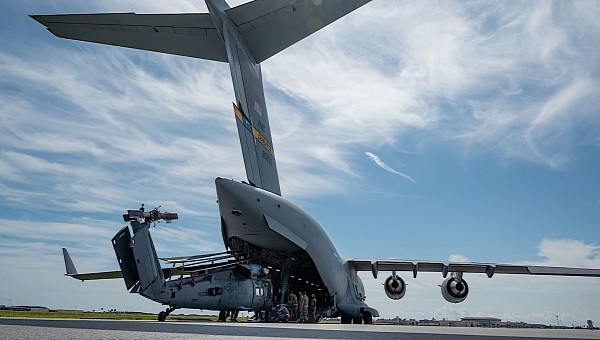Hurricane Ian was one of the biggest storms of the year. Officially a Category 4 hurricane by the time it reached its peak, it originated in the Atlantic Ocean, grew significantly in size, and eventually made landfall in continental U.S., hitting Florida as the deadliest of its kind since 1935.
Before it hit, people living and working in the area in the hurricane's path did their best to safeguard their lives and properties. For the military, that also meant departing the region completely in some cases, as to protect valuable pieces of machinery.
How that was done depends on a variety of factors. In the case of the Patrick Space Force Base in Florida, transporting HH-60G Pave Hawks off-base did not mean flying them out of there under their own power, but loading some onto C-17 Globemasters and moving them to safety.
We see a Pave Hawk being loaded in the main photo of this piece, a still snapped back in late September and recently made public by the U.S. Air Force (USAF) as proof that not even the most potent of human machines cannot match the force of nature.
We see the helicopter, its rotor blades swept to the back, as it gets ready to be placed on the airplane’s ramp and then inside its belly. We’re not told where the helicopter was transported afterwards, but the USAF did say the same thing happened to HC-130J Combat King II helicopters from the same base.
The Globemaster is more than suitable for the task of transporting large military equipment. The massive Boeing plane, powered by four Pratt & Whitney turbofan engines, has a maximum takeoff weight of 585,000 pounds (265,352 kg), and a cargo compartment measuring 88 feet (27 meters) in length, 18 feet (5 meters) in width, and 12 feet (almost 4 meters) in height.
How that was done depends on a variety of factors. In the case of the Patrick Space Force Base in Florida, transporting HH-60G Pave Hawks off-base did not mean flying them out of there under their own power, but loading some onto C-17 Globemasters and moving them to safety.
We see a Pave Hawk being loaded in the main photo of this piece, a still snapped back in late September and recently made public by the U.S. Air Force (USAF) as proof that not even the most potent of human machines cannot match the force of nature.
We see the helicopter, its rotor blades swept to the back, as it gets ready to be placed on the airplane’s ramp and then inside its belly. We’re not told where the helicopter was transported afterwards, but the USAF did say the same thing happened to HC-130J Combat King II helicopters from the same base.
The Globemaster is more than suitable for the task of transporting large military equipment. The massive Boeing plane, powered by four Pratt & Whitney turbofan engines, has a maximum takeoff weight of 585,000 pounds (265,352 kg), and a cargo compartment measuring 88 feet (27 meters) in length, 18 feet (5 meters) in width, and 12 feet (almost 4 meters) in height.









